Derry Mar 20 We left Donegal town around 9:30 this morning and drove north. We stopped at a gas station in Donegal to get some gas and to check the tire pressure since the car keeps telling us that we need to "adjust the tire pressure and reset," but of course there is no manual with the car to give us the instructions on how to reset it. We pulled into a Emo station (that's the gas station brand name), and an attendant pumped our gas. We wondered if there was some prohibition against self-service (no, there's not - we just happened to pull into a station that provides service). The tire pressure was fine, but we still don't know now to reset the danged thing. Our first intended stop was Grianan of Aileagh, an ancient ring fort about 30 miles north of Donegal. But after we navigated the narrow lanes up the hill to the entry gate, there was a truck sitting there with "OPW" on the (Office of Public Works), and the man told us that the site was closed. All day. No entry. So we moved on. 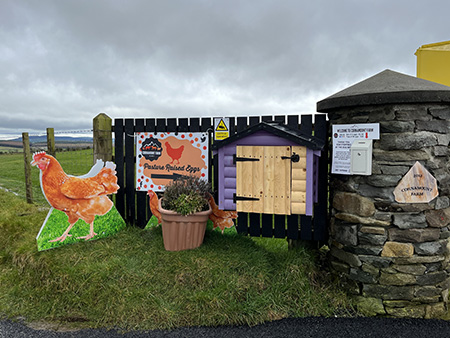
Farmer's eggs for sale near Grianan of Aileagh We continued north along the coast and saw a lovely beach - Lisfannon Beach - which deserved some investigating, so we stopped and walked on the beach. This beach is located on the shores of Lough Swilly, a glacial fjord and inlet of the North Atlantic. It was low tide, so once again we had a great expanse of beach to enjoy. This time, we did not see anyone going for a swim in the chilly waters. 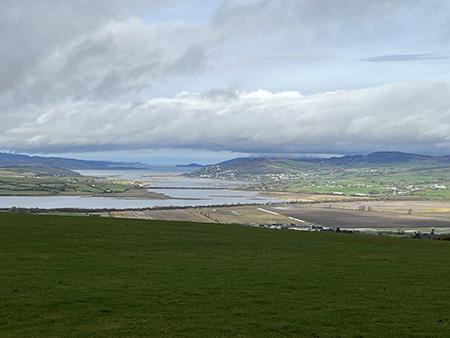
Lough Swilly 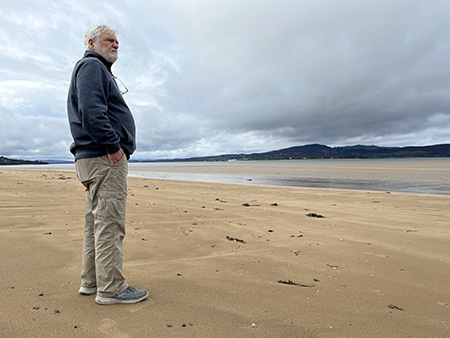
Lisfannon Beach From the beach, we continued north for about 12 miles to a point where we thought we could walk out to Father Hegarty's Rock. But it turned out that we were not at the right spot and had to navigate our way to a different road which led to a parking area and trailhead for a coastal walk. From there, it was about a mile's walk on a paved trail to the place where Father Seamus Hegarty was beheaded in 1711 for the "crime" of saying the Mass. This was during the time of the Penal Laws, when practicing the Catholic faith was forbidden. Father Hegarty was killed at this point overlooking the Lough, and his remains are buried on the hill alongside the trail. We found a small grave, with a memorial stone and several tributes left by visitors, including a small bottle of holy water from Knock. 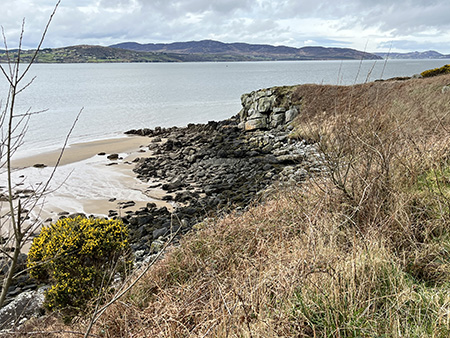
Father Hegarty's Rock 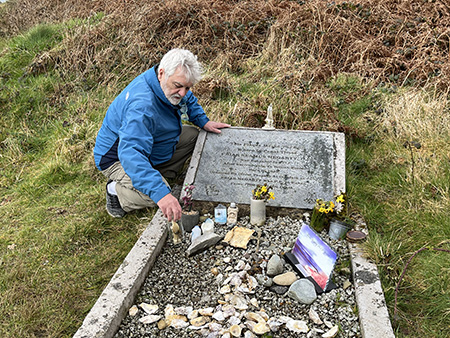
The grave of Father Seamus Hegarty 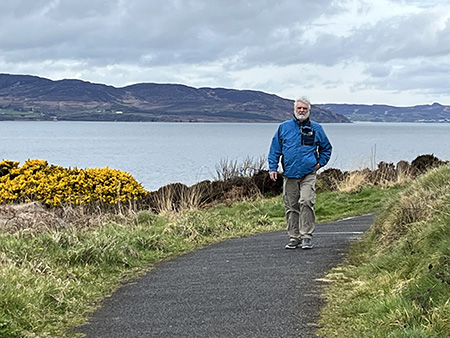
The coastal walk to Father Hegarty's Rock We took some photos, said a prayer for Father Hegarty, and then hiked back to our car. Though the sky was mostly overcast, we were spared any rain, and we enjoyed a few seconds of sunshine on our way back. 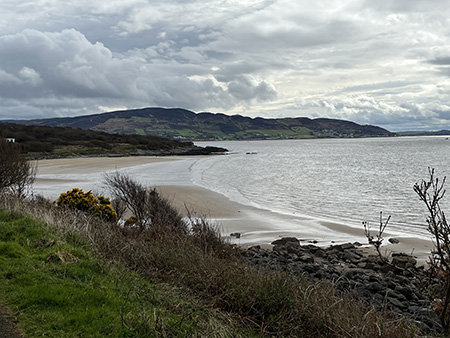
Beach along the coastal walk on the banks of Lough Swilly From Father Hegarty's Rock, it was only 15 miles to our hotel for tonight, the Bishop's Gate Hotel in Derry. We arrived there a little after 2 pm, checked in and got some information on the local surroundings. The hotel clerk had recommended a walking tour, and we saw that there was an opportunity to join a tour at 4 pm. After we dumped our stuff in the room and refreshed ourselves, we decided to take the guided tour. Beforehand, though, we had about an hour to spend on our own, so we walked down the street and climbed up to the city ramparts. We walked most of the complete circumference of the walled city and then headed for the rendezvous point for the walking tour. We had time to get a cup of tea and a scone before we met up with the tour. 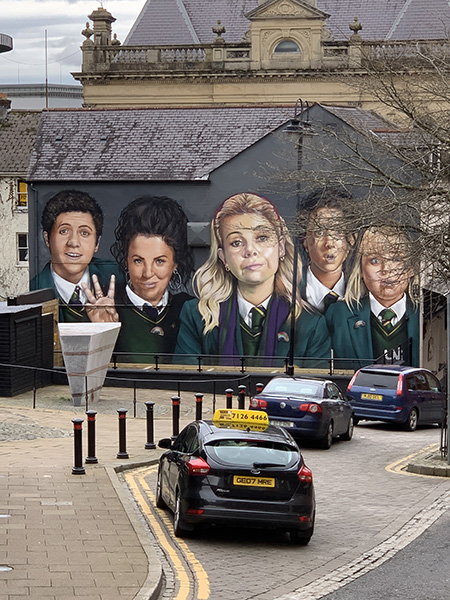
Mural of the Derry Girls Philip of City Walking Tours (https://www.derrycitytours.com) did an excellent job of putting the history of Derry into context. He gave a brief summary of the early history, noting that this place had Neolithic settlements long before St. Columba founded a monastery on the hill in 546 AD. The place, known as Doire Calgach, was renamed Daire Coluimb Chille or "Oak Wood of Colmcille" in his honor. Centuries later, as the British began to get nervous about their enemies France and Spain, they coveted Erin's Isle as a means of covering their western front, so to speak. This led King James I to initiate the Ulster Plantation, which encouraged the settlement of the island with Scots farmers. To protect the British settlers at this point of the inlet from the North Atlantic, James enlisted the help of wealthy merchants in London, who formed a group known as the Irish Society. They more or less paid for the construction of the walled city, and as a nod to their help, James renamed the settlement Londonderry. 
On the ramparts of the walled city of Derry 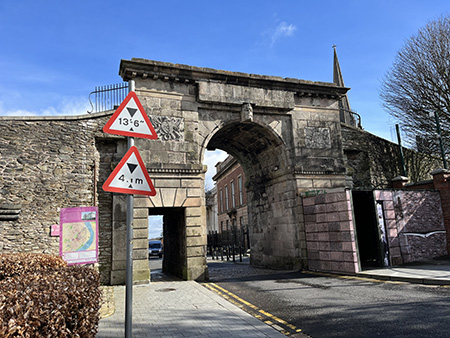
Bishop's Gate - in the old walled city of Derry 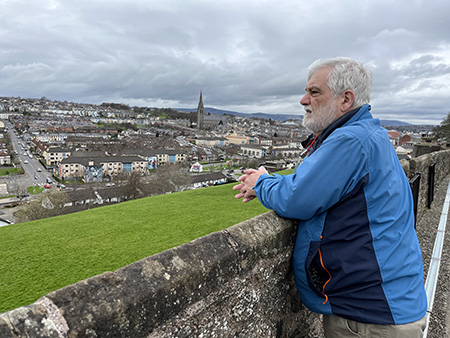
A view of Bogside, the Catholic quarter outside the walled city of Derry After the death of James I and the ascension of James II to the British throne, things started to go from bad to worse. James II (Catholic) was not to the liking of the government in Parliament, so they invited William of Orange (Protestant) to come on over and have a go at being King of England. This did not sit well with James II, so they battled it out at Derry. James II laid siege to the city but was ultimately outlasted when his cannons failed and reinforcements arrived. William chased him down to Slane, where James II was roundly defeated at the Battle of the Boyne in 1690, and he fled to France. 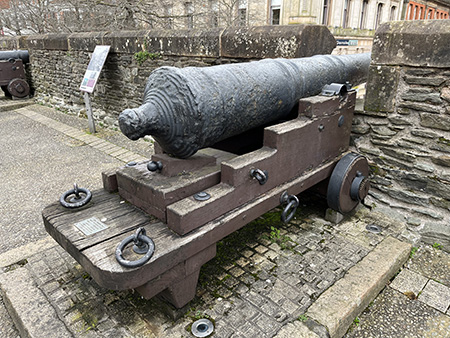
One of the cannons used during the Siege of Derry 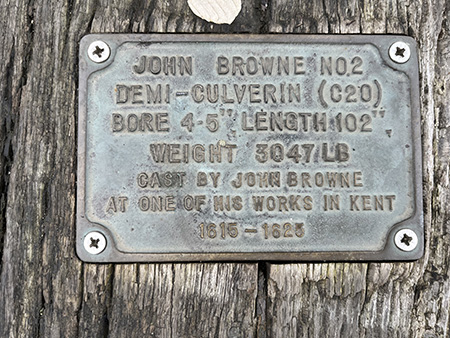
The cannons are called "John Brownes," after their maker The Troubles, though rooted in this war between two kings, is more properly understood as a struggle for civil rights by Catholics in Northern Ireland - specifically in Derry - who were subjected to an extreme form of gerrymandering. Districts were drawn by the Northern Ireland government in a manner to assure that the Catholics would never attain a voting majority. Voting rights were predicated on criteria such as employment and property ownership, and the Unionists controlled both. If one was a Catholic, one was required to live in the Catholic section of town - Bogside, and that section of town was not allowed to grow in terms of its geographic footprint, so as the population increased, conditions deteriorated to the point that multiple families were crammed into single houses. Inspired in part by the civil rights movement in the U.S., the people of Bogside determined that they must take their peaceful protests to the world. Things didn't go well, and extremists on both sides saw an opportunity to exploit the tension for their own purposes. When violence erupted between the Northern Ireland police and protestors, the British government responded by sending in military troops. At first they were welcomed, but once they became targets, things spun out of control and the horrific events of Bloody Sunday were the result. 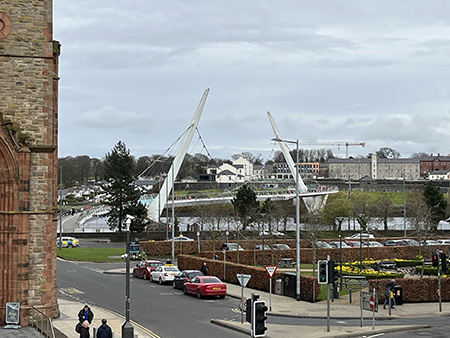
The Peace Bridge across the River Foyle in Derry More recently, however the Good Friday Agreement, signed in 1998, has reversed many attitudes and brought positive change. Though isolated incidents of violence have occurred - again agitated by extremists - the people of Derry and Londonderry are intent on seeing themselves as peaceful neighbors and working hard to make it so. We saw signs of this, with the removal of barriers which had been placed in certain parts of the city and especially with investment in projects to improve the city's employment and economic growth. 
The Windsor Framework offers a potential solution to Brexit-related issues regarding cross-border trade in Northern Ireland We appreciated the tour as it was delivered by our guide, who I think did a good job of providing a balanced view and context for a part of Irish history I have never understood very well. Our guide told us about one ironic bit of history related to a bombing in Derry. The IRA bomber and his accomplice drove to a location near a post office, the intended target. The bomber was carrying the bomb in a satchel, and went in the post office. He was gone a long time before he came back. The driver questioned him, "where were you! What took so long?" The bomber replied that there had been a queue and he did not want to be rude so he had waited in line. The walking tour had been more or less confined to walking ramparts of the city walls - probably not just because it kept the tour from being too long but also because the ramparts provided an excellent point from which to view all sides of the city. We finished our tour at the diamond, the city Square, and the guide noted that the buildings on that street were all in shambles after the Troubles and that they had been rebuilt. Except for the two shops on the corner. One of them was a lingerie shop. Steve said to the guy said, "well, I am glad the bra shop survived." The guide replied, "yeah, it bounced back." One of the other persons in the tour group remarked, "well, it could have been booby trapped." 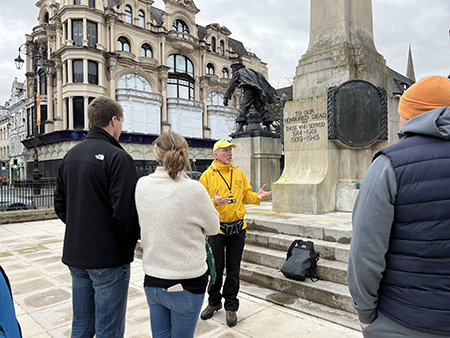
Tour guide for the walking tour of the walled city of Derry. The building in the background is Austin's Department store, established in 1830 and the oldest independent department store in the world. However, it closed its doors abruptly in 2016 and has not reopened. Another tale our guide told us about an incident during the troubles involved the destruction of a statue of Reverend George Walker, a symbol of the Protestant ascendancy, which had rested atop a 96-foot pillar and was bombed on August 27, 1973. Walker was a Williamite, who had come to Derry prior to the 1698 siege, but the presence of his statue was a continuing irritant to the Catholics in Bogside. So they blew it up. The statue flew apart in many pieces, and the head rolled down into the neighborhood of Bogside, where it was picked up by two little boys. They knew what they had, and bargained fiercely with a antique collector to sell it. As our guide said, "after a lot of hard bargaining, they got not one, but two sacks of candy for it." Then the antique dealer turned around and sold it for £18,000, and it is displayed in a museum in Derry. Once we said farewell and thanks to our tour guide, Steve and I took off to walk down through Bogside. This is where one can see a dozen murals depicting people and events of the Troubles and visit memorials to those who were killed in the violence and to the hunger strikers of 1981. I particularly wanted to see Free Derry Corner, a place in the city where graffiti appeared overnight in 1969, reading "you are now entering Free Derry," a direct challenge to the authority of the Northern Ireland government. 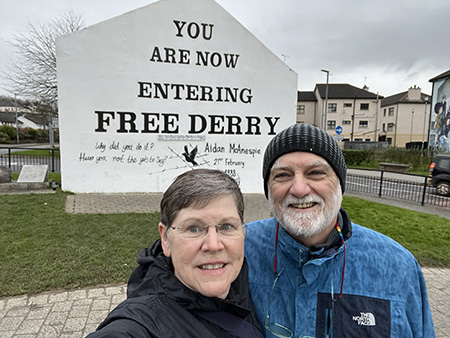
Free Derry Corner As we walked through Bogside, a soft rain began to fall, and we were pretty much soaked by the time we got back to our hotel. We had walked up and down some steep streets, and my legs were feeling it. We went to our room and shed our soggy raincoats, then went back downstairs for dinner at the Wig, the hotel's a la carte dining restaurant. (The other choice was the fixed-price restaurant, the Gown - the hotel is located next to the courthouse.) 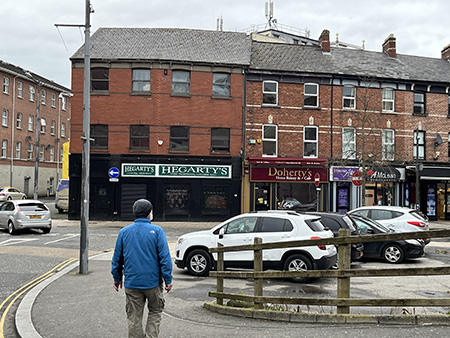
Walking in the Bogside Tomorrow: we go to the Giant's Causeway. Next: To the northern coast and Carrickfergus. |
| Other stuff |
|
back to the top |